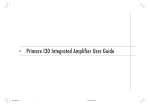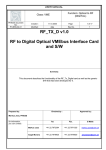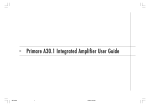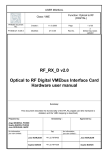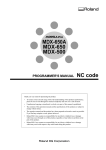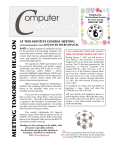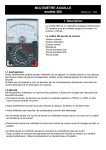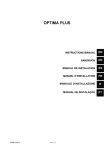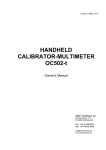Download User Manual - TTC Upgrade
Transcript
USER MANUAL Function: Optical to RF (DIGITAL) Class: VME PH/ESS document No: PH-ESS-02-01 Created : 11.10.2006 Modified: date Page Rev.No. 1 of 29 1 RF_RX_D v1.0 Optical to RF Digital VMEbus Interface Card and S/W Summary: This document describes the functionality of the RF_Rx_Digital card as well as the generic S/W that has been developed for it. Prepared by : Checked by : Approved by : Markus Joos, PH/ESS for information, you can contact : Tel. Fax. E-Mails Markus Joos +41.22.7672364 +41.22.7671025 [email protected] Angel Monera +41.22.7678925 +41.22.7678925 [email protected] PH/ESS Document. No. PH – ESS – ## – ## Page Rev. No. 2 of 29 1 Table of Contents 1. Introduction ........................................................................................................................... 3 2. RF_RX_D Hardware .............................................................................................................. 4 2.1. Power description ........................................................................................................................ 4 2.2. Optical Interface ........................................................................................................................... 4 2.2.1. Photodiodes Modules: .................................................................................................................................5 2.2.1.1. Photodiode selection (Depending of the signal to transmit).................................................................7 2.2.1.2. Photodiode configuration (Threshold and Selection) ...........................................................................7 2.2.1.3. Signal Detection Circuit ........................................................................................................................9 2.2.2. Photodiodes Modules – Post processing Logic...........................................................................................9 2.2.2.1. Frequency divider: ..............................................................................................................................10 2.2.2.2. Output Format Selection.....................................................................................................................10 2.3. VMEbus interface ....................................................................................................................... 11 2.3.1. Addr module sellection ..............................................................................................................................12 2.3.2. Software: Vme addres map .......................................................................................................................13 2.3.3. Registers Description.................................................................................................................................14 2.3.3.1. EDA Identification ...............................................................................................................................14 2.3.3.2. Signal Detection (only for ocp-srx) .....................................................................................................14 2.3.3.3. VRef Registers (Only for TRR or equivalent photodiodes) ................................................................15 2.3.3.4. Frequency Counters ...........................................................................................................................19 2.3.3.5. Board Identification.............................................................................................................................20 2.4. Calibration procedures (Trr or similar photodiode)................................................................ 21 2.4.1. 2.4.2. 2.4.3. Manual Calibration (Fix Vref Values).........................................................................................................21 Through VME Knowing the Signals and Photodiodes used......................................................................24 Through VME Unknowing the Signals and Photodiodes...........................................................................24 2.5. Board configuration- Jumpers and switch .............................................................................. 27 2.6. Fibre / cable connections .......................................................................................................... 27 2.7. Front-panel LEDs ....................................................................................................................... 28 2.8. References or more information............................................................................................... 28 3. TTC common software ....................................................................................................... 29 3.3. 3.3.1. 3.3.2. Introduction ................................................................................................................................ 29 H/W Environment.......................................................................................................................................29 S/W Environment .......................................................................................................................................29 3.4. Test programs ............................................................................................................................ 29 3.5. The user library .......................................................................................................................... 29 PH/ESS Document. No. PH – ESS – ## – ## Page Rev. No. 3 of 29 1 1. INTRODUCTION The RF_RX_D (Optical to RF VMEbus card) is an interface VME card developed as receiver of RF_TX_D VMEbus Interface card. The two boards used together provide 3 digital optical channels, with an 1bit analog to digital converter (comparator), and output LVPECL AC or DC coupled. This document contains a hardware description of the board and all the accessible registers of the RF_RX_D card as well as a description of the generic S/W that has been developed for this card. At the end of this document, some basic examples of configuration procedures are proposed. PH/ESS Document. No. PH – ESS – ## – ## Page 4 of 29 Rev. No. 1 2. RF_RX_D HARDWARE 2.1. POWER DESCRIPTION This board requires a VME crate with the standard VME64 power supply, with +12, -12, and +5 Volts available. The nominal consumption for these power lines is the following: Voltage Current (A) Fuse Current 5V 2A 3A +12V 150mA 0.5A -12V 16mA 0.1A Table 2.1: Power consumption In order to check the power supplied to the board, three LEDs have been installed to indicate the presence of +12V, -12V and +3.3V* (generated from +5V, indicating with this light both voltages). *If this LED is not lighting, proceed checking the +5V fuse state. 2.2. OPTICAL INTERFACE The optical interface is composed of three equal channels based on two parallel circuits using two different photodiodes, one being mounted at a time. Both photodiodes have differential output and are connected to a group of ECL gates that will clean and prepare the signal to be amplified by a coaxial driver and processed with a FPGA. COAX DRIVER MODULE PHOTODIODE SMA CONNECTOR PCL to LVPCL FREQ SPLITTER FPGA Picture 2.2: Optical Interface Diagram PH/ESS Document. No. PH – ESS – ## – ## 2.2.1. PHOTODIODES MODULES: OCP R Power selector Resistor R Truelight Picture 2.2.1.a: Photodiodes Module in EDA 1380 Page Rev. No. 5 of 29 1 PH/ESS Document. No. PH – ESS – ## – ## R Truelight (TRR) Page Rev. No. 6 of 29 1 TRR selector (Disconnect OCP selector) Power supply selector Inductance OCP OCP selector (Disconnect TRR selector) Back side Picture 2.2.1.b: important points in the board EDA 1382 Block Signal Vref Value Light Green OCP Place/ socket Supported: Not adjustable Dark Green Truelight Place/ socket Not supported VIOLET UP RES. 3.3 Volts supply Only one connected VIOLET DOWN RES 5 Volts supply Only one connected PINK RESISTORS Truelight signal selected when 0R0 res. Are placed RED RESISTORS OCP signal selected when 0R0 res. Are placed BLUE RESISTORS Resistor unbalancing the Thevenin Network manually when R /= 0R0 res. BLUE INDUCTANCE FPGA Control Thevenin when placed (1uH) (back side) Table 2.2.1: Block description PH/ESS Document. No. Page PH – ESS – ## – ## 2.2.1.1. 7 of 29 Rev. No. 1 PHOTODIODE SELECTION (DEPENDING OF THE SIGNAL TO TRANSMIT) To the table below summarizes a review coming from the “Laser and Photodiodes Evaluation” that shows the bandwidth and signal types that each Photodiode can receive. For more information and characteristics, check the evaluation document or datasheets. Photodiode Bandwidth Signal Supported Threshold Thevenin adjustable 10MHz square YES NO Tb >10us 10KHz square NO NO Freq > 300Mhz 5ns width 11Khz (pulse) Tb < 10us to 1ns 10MHz square YES NO Freq: ~100 KHz to ~500 MHz 400MHz square Tb > 10us 10KHz square NO NO YES YES Positive pulses YES (maximum 16us width) YES Example OCP SRX 03 Time of bit (Tb) < 10us to 2ns Freq: ~100 KHz to ~250 MHz OCP SRX 03 OCP SRX 24 OCP SRX 24 5ns width 11Khz (pulse) Truelight 50KHz to 400Mhz 10MHz square 400MHz square Truelight Tb(high) < 16us Table 2.2.1.1: Signals supported by each photodiode. 2.2.1.2. PHOTODIODE CONFIGURATION (THRESHOLD AND SELECTION) The table below shows a brief summary of the necessary adjusts that need to be done in each channel to select the photodiode that is going to be used. / PH/ESS Document. No. PH – ESS – ## – ## Photodiode Mode: Page 8 of 29 Rev. No. 1 Components to replace Manual(HW) / FPGA(SW) OCP NOT THRESHOLD ADJUSTABLE OCP CONNECTED (GREEN LIGHT) DARK BLUE (DB) : don’t care LIGHT BLUE (LB) : don’t care PINK RESISTORS (PR): disconnected RED RESISTORS (RR): connected VIOLET RES. (VR): just 0R0 in bottom(5V) Truelight MANUAL THRESHOLD ADJUSTABLE TRUELIGHT CONN. (GREEN DARK) DARK BLUE (DB) : 10ohms resistor LIGHT BLUE (LB) : disconnected PINK RESISTORS (PR): connected RED RESISTORS (RR): disconnected VIOLET RES. (VR): just 0R0 in bottom(5V) Truelight THRESHOLD ADJUSTABLE by FPGA DARK BLUE (DB) : 0ohms resistor LIGHT BLUE (LB) : connected 1uH PINK RESISTORS (PR): connected RED RESISTORS (RR): disconnected VIOLET RES. (VR): just 0R0 in bottom(5V) Table 2.2.1.2: photodiode selection table Insert examples pictures PH/ESS Document. No. PH – ESS – ## – ## Page Rev. No. 9 of 29 1 ******************************************************************************************* In case that another photodiode is going to be used, it has to be connected on: − OCP place if the Output format is pure PECL for all the bandwidth − TRUELIGHT place if the Output is differential NO PECL, with AGC in the last stage of the preamplifier or with and internal AC coupled in the output. In both cases the voltage must be selected between 3.3V and 5V with the Violet Resistors ******************************************************************************************* *In FPGA mode VME FPGA who unbalances the Thevenin network. For this, it is necessary write in the Vref Register a value different from 0. This makes it possible to unbalance the network from ~0 to ~750mv. 2.2.1.3. SIGNAL DETECTION CIRCUIT The signal Detection circuit works ONLY with the OCP SRX photodiode. This circuit will translate the signal detection state from the OCP to the Front panel. A LED on the FP indicates the presence of optical power in each channel through a GREEN light or the absence with a RED light. In a future Firmware version signal detection for Truelight Photodiodes, based on the frequency of the received signal, will be added. Meanwhile, the Frequency detectors registers can be used to know the signal presence 2.2.2. PHOTODIODES MODULES – POST PROCESSING LOGIC The post-processing logic is based on a few ECL gates that will increase the signal power in order to drive the signal through long cables. The user will be able to choose the output format between AC coupled 50 Ω or DC coupled LVPCL. Another function of the Post Processing circuit is to split the signal and apply a frequency divider with the objective to be able to monitor the frequency with the FPGA through the VME interface. PH/ESS Document. No. Page PH – ESS – ## – ## Rev. No. 10 of 29 1 Output CAP: AC/DC coupling selector Picture 2.2.2: Photodiodes Post-Processing Logic 2.2.2.1. FREQUENCY DIVIDER: The Frequency Divider is composed of 5 Flip-Flops (FF) that divide the frequency by 16. 2.2.2.2. OUTPUT FORMAT SELECTION In order to select the format of the output (50Ω AC coupled ~800Vpp) or DC coupled LVPECL, you must place in the output of the system a capacitor of 100 nf (AC) or a 0Ω RESISTOR for DC coupling. Insert picture capacitor output Picture 2.2.2.2: Location of the Output Capacitor 0R0 Resistor PH/ESS Document. No. PH – ESS – ## – ## 2.3. Page Rev. No. 11 of 29 1 VMEBUS INTERFACE The VMEbus interface of the RF_RX_D cards is implemented in its FPGA and based on a VHDL Module developed by the AB/RF group. This Module has been developed especially for VME64 but adapted for using some functionality of VME64X (like automatic addressing). The firmware installed has been configured to work in the addressing mode of: A24/D16 and works as a memory decoder, where all the memory space is available. The access modes (dictated by address modifier) are only available for 0x39 and 0x3D, where the there is no distinction between privilege user and normal user From this 24bits of memory address, 6 bits are used for the module address [A23 to A18]. This address can be set up using the two rotary switches. SW1 SW2 Picture 2.3: Module address selector In addition, it is possible to fix automatically the module address by using the geographical address of VME64x. In order to select the source of the module address (rotary switches or GEO addr.), from the 8 bits of the R.S. the 2 lower bits are designated to select it. PH/ESS Document. No. Page PH – ESS – ## – ## Rev. No. 12 of 29 1 2.3.1. ADDR MODULE SELLECTION Address space available: Note: M represent XXXX (any combination of 4 bits) N represent XX (any combination of 2 bits) 0xM(N+0)0000 to 0xM(N+3) FFFF Rotary Switch 1 Rotary Switch 2 M Bits(3:2)= N Î 256 Kbytes of memory Module address (MA) Automatic GEO Address (5bits + 0)* Bits(1:0)= “1 to 3” M [A23…A19] <= GEOGA(4 : 0) A18 <= 0 Bits(3:2)= N 0xMN Manual Address Bits(1:0)= “0” [A23…A20] <= M [A19…A18] <= N *Requires VME64X crate Table 2.3.1: Address and ADDR Mode selection In others words, the bottom rotary switch (sw1) controls the addressing mode with the lower two bits, which switches to automatic mode if the bit(0) or bit(1) = 1. Examples: Rotary Switch 1 Rotary Switch 2 0xF 0 Module MODO / ADDRESS / SPACE Manual address Module address: 0xF0 0000 Board space: 0xF00000 to 0xF3 FFFF 0xF 1 Automatic address Module address: Depends on the slot into which the card is plugged 0xF 4 Manual address Module address: 0xF4 0000 Board space: 0xF40000 to 0xF7 FFFF Table2.3.1.b: Examples of Module Addr PH/ESS Document. No. PH – ESS – ## – ## Page Rev. No. 13 of 29 1 2.3.2. SOFTWARE: VME ADDRES MAP Offset Size (bytes) Function Mode Remarks 0x0000 2 EDA ID Read 0x1382 0x0004 2 SIG_DETEC** Read bits 3 to 1 0x000A 2 CH1_REF* Read / Write 0x000C 2 CH2_REF* Read / Write 0x000E 2 CH3_REF Read / Write 0x0010 2 CH1_FREQ_LOW Read Freq Ch1 (15..0) 0x0012 2 CH1_FREQ_HIGH Read Freq Ch1 (31..16) 0x0014 2 CH2_FREQ_LOW Read Freq Ch2 (15..0) 0x0016 2 CH2_FREQ_HIGH Read Freq Ch2 (31..16) 0x0018 2 CH3_FREQ_LOW Read Freq Ch3 (15..0) 0x001A 2 CH3_FREQ_HIGH Read Freq Ch3 (31..16) 0x003A 2 BOARD ID (CERN ID) Read 0x016C Others Unused Table 2.3.2: VME Memory Map * These Registers only modify or affect the TRR photodiode (or any Photodiode placed in its sockets) ** These Registers only affect the OCP photodiodes PH/ESS Document. No. Page PH – ESS – ## – ## 14 of 29 Rev. No. 1 2.3.3. REGISTERS DESCRIPTION 2.3.3.1. EDA IDENTIFICATION Name Offset Size Access EDA ID 0x0000 16 bits R The EDA ID is just a register that can be used to identify the board. This default value is 0x1382, which correspond to the EDA number assigned to the project. 2.3.3.2. SIGNAL DETECTION (ONLY FOR OCP-SRX) Name Offset Size Access SIG_DETEC 0x0004 3 bits (3:1) R The register Signal Detect represents the signal detection in the OCP photodiodes (if there are not OCP SRX installed, the value of this register can be false). This register is connected to the front panel LEDs that indicate the signal presence with a green light and no signal with red light. For other photodiodes, use the frequency counters registers. Examples: Hex Value SD in Ch 1 SD in Ch 2 SD in Ch 3 0x00 0x02 X X X 0x08 0x0A X 0x0C 0x0E Nothing: No signal X 0x04 0x06 X: Signal Detected X X X X X X X Table 2.3.3.2: Signal detection combinations PH/ESS Document. No. PH – ESS – ## – ## 2.3.3.3. Page Rev. No. 15 of 29 1 VREF REGISTERS (ONLY FOR TRR OR EQUIVALENT PHOTODIODES) These registers only work with the photodiodes plugged in the Truelight socket. Name Offset Size Access Default Values CH1_REF 0x000A 8 bits R/W 0x000A CH2_REF 0x000C 8 bits R/W 0x000A CH3_REF 0x000E 8 bits R/W 0x000A CHX_REF are a group of register that control the previously mentioned Thevenin Network in the 3 channels. The values of these registers will be sent to the DAC to modify the network. The modification is linear and follows the equation: Vdiff = V + − V − = 120 • Voff (202 + R ) − Vcc • R (202) • (202 + R ) Voff (mV ) = DACvalue * 4.7mV Where: Vdiff is the differential voltage between the differential lines Voff is the DAC voltage value R is the Manual Thevenin modifier Supposing a R=0 we can obtain this graph where is possible to select graphically the value for the register (the value is in Decimal, do not forget to change to hexadecimal) PH/ESS Document. No. Page PH – ESS – ## – ## 800,00 Rev. No. 16 of 29 1 Vdiff 700,00 600,00 Vdiff (mV) 500,00 400,00 300,00 200,00 Optimal Value for Sinusoidal/Square signals (0x00) 100,00 0,00 50 0 Default value for everything (TRR) 100 150 200 Register Value (DEC) Optimal value for pulse (TRR) (0x15) Picture 2.3.3.3a : Vdiff variation with Vref_register Positive pulse Vdiff (0) V- Output V+ Reference for BOTH LINES Negative pulse Noise when low level is keep more than 10us Picture 2.3.3.3b: Positive pulse in balanced Thevenin network 250 PH/ESS Document. No. Page PH – ESS – ## – ## Positive pulse V- 17 of 29 Rev. No. 1 New reference for Negative Line (Controlled by VME) Theoretical reference for BOTH LINES Vdiff V+ New reference for Positive Line (Controlled by hardware – Resistor - Out Pulse width reduced Picture 2.3.3.3c: Positive pulse in an Unbalanced Thevenin network V- New reference for Negative Line (Controlled by VME) Negative pulse Vdiff V+ Out No cross NO signal Theoretical reference for both LINES New reference for Positive Line (Controlled by hardware – Resistor - Picture 2.3.3.3d: Negative pulse in an Unbalanced Thevenin network Review: When the network is balanced, the user must avoid keeping a level for more than 10us. When the network is UNBALANCED, the network will force zero detection when there is no signal, negative or zero signal. When a positive level is received, the output will change to positive following the received signal for a maximum of 10us will received. Examples of Outputs with unbalanced network: Input Output notes Low level 50 seconds Low level 50 seconds Low (50s) high(5us) low (50s) Low (50s) high(5us) low (50s) Low (50s) high(50us) low (50s) Low (50s) high(~10us) low (50s+ 40us) AGC actuation, setting up the level received to 0 PH/ESS Document. No. PH – ESS – ## – ## Page Rev. No. 18 of 29 1 Examples of VREF adjustment: Supposing just FPGA modification (R=0), the Vdiff can vary from 0 to 0.71Vots (Voff = .2V (0xFF in the Vref Register)) The Comparator used (ADCPM553) nees, at least, 10mv of differential voltage between its inputs. If we don’t want the comparator to oscillate, we need to fix the Vdiff voltage in at least 20/30mV (minimum voltage + some more for noise immunity). Then, the value to write in the register (following the equations or the graph) is 0x0A. This value ensures the reception of all the signals with all the receivers but is not optimised. Note: any value different from 0 will generate duty cycle distortion in the high frequency signals. The user must decide what he exactly needs and set up these values as convenient is for him. Insert pictureeeeeeeeeeeeeeeeeeeeeeeeeee PH/ESS Document. No. Page PH – ESS – ## – ## 2.3.3.4. Rev. No. 19 of 29 1 FREQUENCY COUNTERS CH1 Name Offset Size Access CH1_FREQ_LOW 0x0010 16 bits R CH1_FREQ_HIGH 0x0012 16 bits R Name Offset Size Access CH2_FREQ_LOW 0x0014 16 bits R CH2_FREQ_HIGH 0x0016 16 bits R Name Offset Size Access CH3_FREQ_LOW 0x0018 16 bits R CH3_FREQ_HIGH 0x001A 16 bits R CH2 CH3 These registers are generated by internal counters that count the number of rising clocks between rising edges in the received signals. In order to measure higher frequencies than the clock frequency, a frequency divider has been installed on the board (4 hardware Flips-Flops = > 1/16) and inside the FPGA (software divider 1/22) Every counter has a size of 32 bits that is divided in two registers of 16bits that must be read separately due to the fact that the board has only A24/D16 access. In order to calculate the frequency, the equation is: Freq = 80 • 16 • 22 Re gLow + Re gHigh • 65536* * This multiplication must be done in LONG UNSIGNED INT or FLOAT PH/ESS Document. No. Page PH – ESS – ## – ## Rev. No. 20 of 29 1 Examples: Frequency Original (MHz) ValueReg1 Value Reg2 Frequency Measured (MHz) 10 0x0000 0x0B00 10 40.078 0x0000 0x02BF 40.0568 0x0000 0x02BE 40.113 0x0000 0x0047 396.619 0x0000 0x0046 402.285 Pulse 1MHz 0x0000 0x6e00 1MHz Pulse 11.245KHz 0x0026 0x361A 11.245027KHz No signal 0xFFFF 0xFFFF 6Hz 400.78 Table 2.3.3.4 : Typical examples of values of the frequency counter 2.3.3.5. BOARD IDENTIFICATION Name Offset Size Access BOARD ID 0x003A 16 bits R This register contains the VME64x board ID of the RF-RX and is set to the value 364 ( = 0x16C). See http://ess.web.cern.ch/ESS/boardIDistribution/PHP/ for details PH/ESS Document. No. PH – ESS – ## – ## 2.4. Page Rev. No. 21 of 29 1 CALIBRATION PROCEDURES (TRR OR SIMILAR PHOTODIODE) The calibration procedure will apply only to the channels where a TRUELIGHT or equivalent photodiode is installed. The OCP photodiodes DO NOT REQUIRE ANY CALIBRATION. Only be selected (see section 2.2.1.1) The calibration procedure can be done manually or trough VME, dividing this last option in two different scenarios. Knowing the frequency and type of the signal received Unknowing the frequency and type of the signal received In order to read and modify the board’s registers the program rfrxscope * has been developed. It helps the user accessing the board registers in an interactive way. * rfrxscope has been written by Markus Joos. 2.4.1. MANUAL CALIBRATION (FIX VREF VALUES) This configuration will be applied when a VME controller is not present or block the references to avoid third part modifications or intromission. The manual modification is done by modifying the Resistors R and disconnecting/desoldering the inductance (more information about full Truelight Set UP in section 2.2.1) PH/ESS Document. No. Page PH – ESS – ## – ## R Rev. No. Inductance Picture 2.4.1a: Manual Calibration set UP In order to calculate the R convenient the user must follow the equation: Vdiff = V + − V − = 120 • R= Or the next Graphs: Vcc • R (202) • (202 + R ) 202 • Vdiff Vcc • 0.594 − Vdiff 22 of 29 1 PH/ESS Document. No. Page PH – ESS – ## – ## 70,0 23 of 29 Rev. No. 1 R/Vdiff 60,0 R(ohm s) 50,0 40,0 Important values: 30,0 Freq R in Ohms 20,0 >1MHz (centred in 0) 0 10,0 Pulses 3.5 All (not optimal) 2.1 0,0 0 200 7,0 400 600 800 Vdiff (mV) R/Vdiff 6,0 R(ohms) 5,0 4,0 Important values: 3,0 2,0 1,0 Vdiff R in Ohms 0mV 0 20mV 1.4 30V 2.1 50V 3.5 0,0 0 20 40 60 Pictures 2.4.1b: Calibration Graphs 80 100 Vdiff (mV) PH/ESS Document. No. PH – ESS – ## – ## Page 24 of 29 Rev. No. 1 2.4.2. THROUGH VME KNOWING THE SIGNALS AND PHOTODIODES USED. The calibration can be done with monitor software like rfrxscope (By Markus Joos) or with readRXD monitor (Tcl application that run over Markus Joos Vme_Drivers). If the user is close to the board and knows the type of receivers that are mounted and which signal type they are receiving. Then, apply these rules Photodiode Signal Vref Value OCP SRX 03 1Mhz to 100Mhz clocks No adjustment required OCP SRX 03 400Mhz or Pulses clocks Don’t care – Not supported OCP SRX 24 1Mhz to 500Mhz clocks No adjustment required OCP SRX 24 Pulses Don’t care – Not supported Truelight 0.5Mhz to 400Mhz clocks Required: 0x00 Truelight Pulses Required: 0x15 Truelight Any (not optimal) Required: 0x0A Table 2.4.2: Manual Calibration Values 2.4.3. THROUGH VME UNKNOWING THE SIGNALS AND PHOTODIODES This will be the procedure (algorithm) to apply when the user doesn’t know what types or receivers are installed in the board and which types of signals are received. Like in the same procedure, VME access software will be required in order to read and modify the desired registers. PH/ESS Document. No. Page PH – ESS – ## – ## This value works with all the signals with an optical power from 0dbm to -26dbm (Not Optimal Value) Wait 54 secs If there is a Truelight Write 0xFF with NO pulse, this will block the signal, revealing the OCP if we Wait 54 continue Receiving secs Write 0x0A 10Hz<F<100Khz Frequency ? Blocking signal: F > 10Hz 1 Initialization: Start Write 0x0A F>100Khz Rev. No. 25 of 29 <10Hz or 0XFFFF FFFF NO SIGNAL END END Frequency ? <10Hz or 0XFFFF FFFF Write 0x3A** (TRUELIHT) (TRUELIHT) Write 0x00 END OCP END (TRUELIHT) Picture 2.4.3: Remote Calibration Procedure ** This value is the minimum value to accept the pulse in good conditions and correspond to the worst scenario possible (signal reception at -27dBm). More values can be found in the next tables and graphs PH/ESS Document. No. Page PH – ESS – ## – ## Power Received in dBm (5.6ns width) -5 -7 -9 -11 -13 -15 -17 -19 -21 -23 -25 -27 Rev. No. Value Hex for obtain a output Pulse widh of 5,6ns 0xB5 0XA0 0X88 0X78 0X70 0X70 0X70 0X65 0X58 0X4C 0X44 0X3A Pw (uW) 316 199 125 79 50 31 19 12 7 5 3 1 26 of 29 1 Value Dec 181 160 136 120 112 112 112 101 88 76 68 58 TRR V reference value for Pulse transmision 200 Vref Value por input/output pulse 5,7V 180 160 140 120 100 80 60 40 Tx Configuration Ch3 with Vref 0x70 (560mv) 5,6ns width pulse 20 0 -30 -25 -20 -15 -10 0 -5 dBm received in TRR TRR V reference value for Pulse transmision 200 Vref Value por input/output pulse 5,7V 180 160 140 120 100 80 60 40 Tx Configuration Ch3 with Vref 0x70 (560mv) 5,6ns width pulse 20 0 0 50 100 150 200 uW received in TRR 250 300 350 PH/ESS Document. No. PH – ESS – ## – ## 2.5. Page 27 of 29 Rev. No. BOARD CONFIGURATION- JUMPERS AND SWITCH Element Description LSB rotary switch See 2.3.1 section MSB rotary switch See 2.3.1 section Reset(Front Panel) button Generate a Soft reset of the FPGA when is pressed ST5 Always OFF ST4 Always ON TP25 Frequency selector0 for the JTAG TP26 Frequency selector1 for the JTAG ST3 If ST3 is ON -> the FPGA will be reprogrammed when the VME crate reset will be activated (triggered by a VMEbus SYSRESET) Table 2.5: Jumpers and Switch descriptions 2.6. FIBRE / CABLE CONNECTIONS Connector name To be connected to Format CH1 IN Optical Link RF Digital TX Optical (Digital or Analog) CH1 RF Out 50omhs LOAD LVPECL 50ohms AC/DC coupled CH2 IN Optical Link RF Digital TX Optical (Digital or Analog) CH2 RF Out 50ohms LOAD LVPECL 50ohms AC/DC coupled CH3 IN Optical Link RF Digital TX Optical (Digital or Analog) CH3 RF Out 50ohms LOAD LVPECL 50ohms AC/DC coupled J5 JTAG JTAG MODE (FPGA) J6 JTAG BIT BLASTER MODE (EEPROM) Table 2.6: Connectors and Descriptions 1 PH/ESS Document. No. PH – ESS – ## – ## 2.7. Page Rev. No. 28 of 29 1 FRONT-PANEL LEDS LED Description VME COMM Indicates if the last VME cycle was successful or wrong ERROR LED Indicates an error in ????? CH1 LED (SD CH1) Indicates Optical signal (only OCP*) when is receiving >-30dbm CH2 LED (SD CH2) Indicates Optical signal (only OCP*) when is receiving >-30dbm CH3 LED (SD CH3) Indicates Optical signal (only OCP*) when is receiving >-30dbm Table 2.7: Front Panel LEDS *Possible modification in the definitive board for signal detection based in the Frequency detection valid for all photodiodes. 2.8. REFERENCES OR MORE INFORMATION Lasers and Photodiodes evaluation (by Angel Monera) EDA documents (https://edms.cern.ch/nav/eda-01382) RF_RX_D TCL console Manual RF_TX_D User Manual PH/ESS Document. No. PH – ESS – ## – ## 3. TTC COMMON SOFTWARE 3.3. INTRODUCTION 3.3.1. H/W ENVIRONMENT 3.3.2. S/W ENVIRONMENT 3.4. TEST PROGRAMS 3.5. THE USER LIBRARY Page Rev. No. 29 of 29 1





























